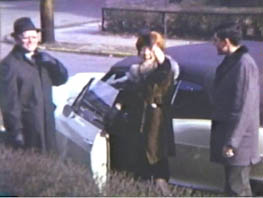Mom & I is a different kind of mommy blog. It is not for young mothers with young children. While I’m the mother of an adorable 5-year-old bishon frise named Truffle, this blog is about my mother and me. Actually, it’s about two mothers, my late mother, Ruth Kurman, who died 42 years ago when I was 13 and my other mother, Celia, who married my father when I was 21.
Mom & I is for all daughters and sons of aging parents.
I’m going to tell stories, offer insights, and hopefully provide resources to help you understand what to expect as your parents age.
This blog is about how the many powerful women in my life helped to shape who I am and how their actions affected me and everyone in my extended family.
This is, of course, my opinion. I am not a therapist. I have no professional training in the area. I am a daughter. A daughter-in-law. Mother to Truffle. And, wife to Lee Barrie.
As you read,I hope that you’ll think about your own life. You may have your own stories to tell. I urge everyone reading this blog to post your thoughts. I’m looking forward to the journey.
Mom & I. Helping each other by discovering the common thread that makes us one.



Cindy – I had saved this from Twitter and I was really touched by it: http://www.emergencemarketing.com/2010/01/08/personal-remembering-my-mom/
My Father’s Fathers Draft
Sunday’s with Mom
My heritage sings through my veins. My entire body resonates to the extraordinary deep bass male voices of “Blessed is the Man”, an Eastern Orthodox chant, “who walks not in the Council of the wicked, Aleluia”. My ears thrill to Kalinka, a drinking song evoking snow covered hills, whirling dancing figures, unfaithfulness, a small red and sour berry and a Russian girl’s beautiful name.
The scent of Frankincense, Myrrh and Byzantium permeates my brain, nose and pores as I inhale this fragrance into my body. A bearded Orthodox priest proceeds up the aisle, swinging back and forth a brass censer containing this incense. On his way to the magnificent iconostasis which consists of three tiers of holy icons, a boundary between the divine and human, and a middle door known as the Holy Doors or Royal Gates through which he passes to conduct service at the altar or Holy Table representing the Throne of God and the Holy Sepulcher. The sanctuary is placed behind the iconostasis also. A seven branched candle stand (the manualia) holding burning tapers is aflame on the altar. Another is in the tabernacle. The candelabra is said to represent the seven heavens that encompass our world and smoke from the candles mingle with the scent of incense to pass to the heavens where dwell powers and angels and archangels worshipping the Almighty God who created all things. When I was young, the faithful beat their chests during mass and chanted “Hospodi Pomiliy” or Lord Have Mercy while crossing their breasts from right to left, in response to the readings. To experience awe within the sanctuary of the Greek Orthodox Church had a profound effect on my life, one that infused my soul with a lust for beauty and a need to search for further meaning in my life. You could say I was imprinted at the early age of three by my ancient Slavic ancestry and my mother’s unfaltering faith. In my memories she allowed me to lay on the pew with my head on her lap during this lengthy but exquisite service that I remember to this day. I am 72 years old.
I must mention the bells. They ring slowly and rhythmically when announcing mass. In many places all orthodox churches ring out at the same time to beacon the faithful. Hear the Russian Orthodox bells echoing and ringing in unison while announcing the defense of Russia over Napoleon’s Grand Armee at the Battle of Borodino in Tchaikovsky’s last movement of the 1812 Overture. “God Save the Tsar“ is constructed in counterpoint to “La Marseilles”, the French National Anthem. The constant repetition of “God Preserve Thy People”, harmonizing with persistent chiming bells and cannons booming, totally obscures the threat of Napoleon’s Armee. Another treat to listen to is also incorporated in this Overture. “Blazhen Muzh” or “Blessed is the Man” sung by the Don Cossack Choir from the Pechersk Monastery in Kiev can be heard on You Tube. This music is exhilarating, chilling and deadly as wars tend to be. It sends shivers up my spine. The Overture first performed at the Christ the Savior Church in Moscow in 1822 is now known